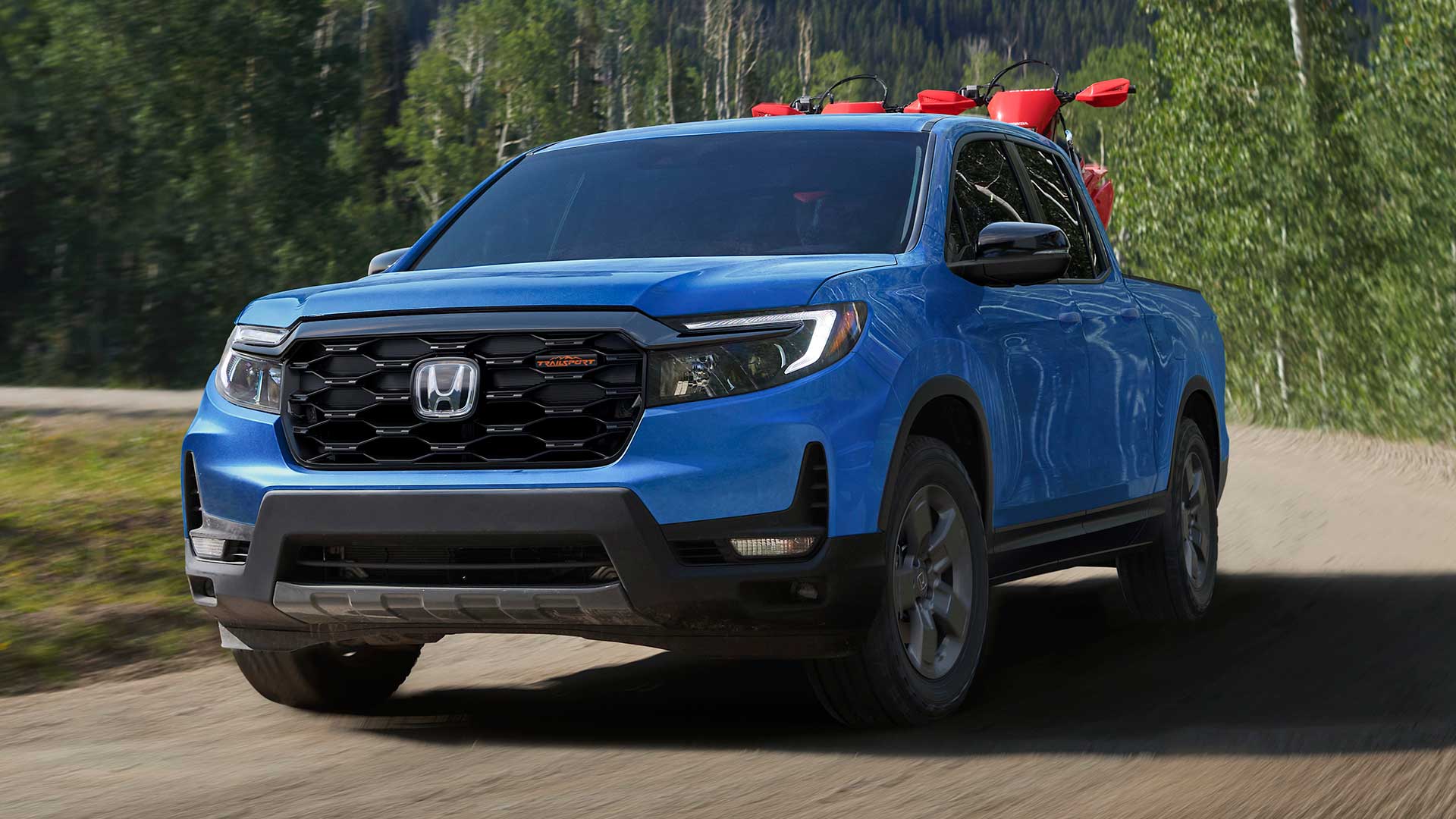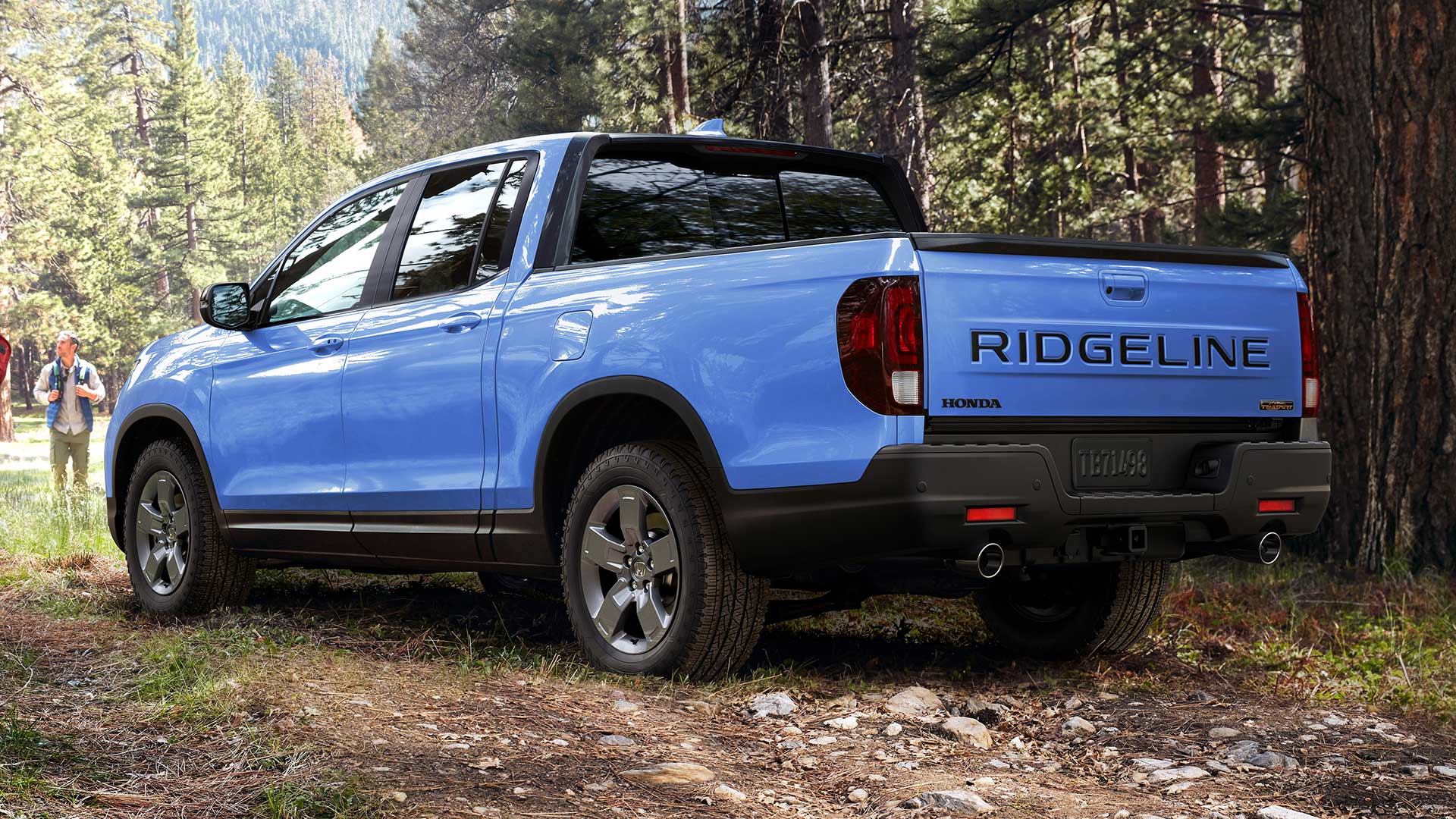2010 Mercedes-Benz E-Class
With the economy still in question, car sales continue to suffer, no matter what the brand, or how well-heeled the customer. So as Mercedes-Benz prepared the launch of their all-new E-class, they made the decision to hold nothing back. They wanted to make their mid-size sedan and coupe as appealing as the flagship S-Class, but for a lot less money. Now it’s time to see if they’ve succeeded.
The E-Class is the proverbial backbone of Mercedes-Benz, and the all-new 2010 edition arrives with an edgier look and more techno-goodies than we can count.
Joining the classic sedan is a new E-Class Coupe, replacing the CLK.
We tested both the sedan and coupe side by side. While our duo shared the same deep black finish, and crease styling theme, each body style has plenty of unique details.
Let’s dissect the sedan first. Both in Luxury and Sport forms, it is more aggressively-styled, borrowing elements from the ConceptFASCINATION show car.
Oval front lamps have given way to wedgy housings, with hockey-stick LED driving lamps below. Still, our Sport model’s tri-bar grille is most familiar, as is the standup three-pointed star.
Strong fender flares and brawny character lines lead back to a thick rear also decorated with LEDs, along with dual exhaust cutouts.
The 5-passenger interior is less dramatic, defined by lots of wood and fine grained upholstery, but now filled with S-Class like luxury and technology.
Our sedan’s multicontoured seats look flat, but use active bolsters to help maintain body position during cornering.
Much of the new technology is for safety’s sake. Standouts include Nightview Assist, Adaptive Highbeam Assist, and Lane Keep Assist. There’s even standard Attention Assist that monitors your inputs and will alert you if it thinks you’re falling asleep at the wheel.
And in addition to the normal front and side impact airbags, there are now two front pelvic airbags and one for the driver’s knees.
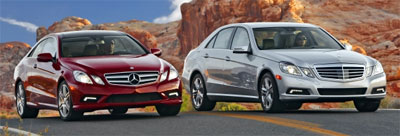 In the center of it all is Mercedes’ latest, and now standard COMAND interface, it governs the sound system, Bluetooth interface, and available navigation.
In the center of it all is Mercedes’ latest, and now standard COMAND interface, it governs the sound system, Bluetooth interface, and available navigation.
The sedan’s rear seat is both comfortable and spacious, and the low lip trunk provides a sizeable 19.1 cubic feet of space.
The E-Class coupe sheds both wheelbase and length, for an even more athletic shape.
You instantly think it’s capable thanks to a more open, twin-bar grille that surrounds an oversized star logo.
From there, lines flow pass its clamshell hood and along frameless doors and a pillarless greenhouse for a true two-door hardtop design.
Taillights and rear deck treatments are also sharper, for a nicely dynamic rear-view.
The Coupe’s interior is a more intimate, four-seat layout, but the standard panoramic sunroof keeps it from feeling confined.
Other differences include less wood and chrome, a dark surround to the five-gauge cluster, sportier bucket seats, plus steering wheel and console mounted shifters compared to the sedan’s column mounted flip switch.
The rear seat is expectedly tighter than that of the sedan, especially in legroom. The 15.9 cubic foot trunk is also smaller, but still accommodating.
Power for the E-Class is carryover. The E350 is equipped with a 3.5-liter V6 with 268-horsepower and 258 pound-feet of torque; with the E550’s 5.5-liter V8 doling out 382-horsepower and 391 pound-feet of torque.
Both tied to a 7-speed automatic which feeds the rear wheels for now.
A 4MATIC all-wheel drive sedan will be available later in the model year, along with the road-scorching E63 AMG, and a super thrifty E350 BlueTech clean diesel.
At the track, the E350 sedan will trot from 0 to 60 in 7.0 seconds, with a quarter mile of 15.5 seconds at 92 miles per hour. The 3.5 seven-speed combo isn’t a powerhouse, but it’s a decent performer with quick shifts.
The multi-link suspension with standard Agility Control yields a very nimble response without a harsh ride. Throughout our test the sedan remained firmly planted with plenty of grip.
Brakes were impressively solid too, with virtually no dive and minimal fade. Our 124 foot average from 60 to 0 rates great.
The E550 Coupe conquered our 0 to 60 run in just 5.6 seconds, with a fast quarter mile of 14.1 seconds at 105 miles per hour. Power never stopped building, with the deep and throaty exhaust note just egging us on.
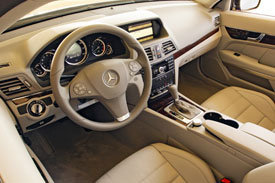 Through the cones, our E550 Coupe felt a good bit stiffer than the E350 Sedan thanks to the standard Dynamic Handling Suspension’s adjustable shocks and modified throttle response. It was actually a little twitchy, especially at lower speeds. But the faster we went, the more precise it became.
Through the cones, our E550 Coupe felt a good bit stiffer than the E350 Sedan thanks to the standard Dynamic Handling Suspension’s adjustable shocks and modified throttle response. It was actually a little twitchy, especially at lower speeds. But the faster we went, the more precise it became.
Our only disappointment were the brakes. Stops were solid, but at 135 feet from 60 to 0, a tad long with noticeable fade.
Mercedes-Benz has honed E-Class aerodynamics to make them sip fuel like smaller rivals. Our slippery E350 Sedan has Government Fuel Economy Ratings of 17 city/24 highway on Premium gas, with a 23.6 miles per gallon test loop.
Ditto the E550 Coupe with 15 city/23 highway, and 21.5 miles per gallon on mixed roads.
Pricewise, the E-Class is also a better value than last year. The Sedan starts are $49,475. That’s a drop of about $4,800. The Coupe begins at $48,925, or about the same as the less well equipped CLK.
So competitors beware. The new 2010 E-Class is even more formidable than before. With artistic styling, top drawer luxury and technology, and the addition of a new coupe, the “E-Class” remains the spear carrier of the Mercedes-Benz lineup.
Specifications
- E350:
- Engine: 5.5-Liter V8
- Horsepower: 382
- Torque: 391 Lb Feet
- 0-60 MPH: 5.6 Seconds
- 1/4 Mile: 14.1 Seconds @ 105 MPH
- 60-0 MPH: 135 Feet
- EPA: 15 MPG City/ 23 MPG Highway
- Mixed Loop: 21.5 MPG
- E550:
2024 Honda Ridgeline TrailSport
It Does Truck-Like Things Better Than Ever
Honda brought something truly unique to the pickup truck scene when their mid-size Ridgeline debuted for 2006. In 2017, it moved towards becoming a little more true truck-like, both in form and capability, now with yet another step in that direction for 2024. So, let’s see if the Ridgeline is really hitting its stride.
For 2024, it’s all about making this Honda Ridgeline better than ever. There are styling tweaks outside, along with tech and functional improvements inside, but the biggest news is the Ridgeline has now joined Honda’s TrailSport family of off-road inspired vehicles. This more-true-trucklike, second-gen Ridgeline been around since 2017, receiving periodic updates over the years; but joining the TrailSport family is the biggest leap yet.
Primarily, the TrailSport transformation includes General Grabber all-terrain tires, mounted on new Pewter Gray 18-inch wheels, steel underbody protection, and retuning the strut front, and multi-link rear suspension for added wheel articulation. And while we always appreciate the additional traction of off-road tires, the Ridgeline’s standard i-VTM4 all-wheel drive, with Intelligent Traction Management and snow, sand, and mud settings, was already quite capable of handling all but the most extreme off-roading, ground clearance of just 7.6 inches being it’s only real hinderance.
A 3.5-liter V6 remains under the hood as it has since the Ridgeline debuted for 2006; the current version outputs 280 horsepower and 262 lb-ft of torque, plenty enough muscle to handle its 5,000-lbs. towing capacity. A nine-speed automatic transmission with paddle shifters and bevy of push and pull buttons on the console replaced the six-speed automatic back in 2020.
In addition to adding TrailSport capability, a big focus for this update was making it more user-friendly inside, starting with the central touchscreen growing from 8 to 9 inches. It also gets faster processing speeds, menus have been simplified, and the native navigation system is improved with better graphics. It’s accompanied by a new digital instrument cluster, along with an upgraded center console with more storage space. Unique TrailSport touches include heavy duty floormats, leather-trimmed seats, orange stitching throughout the cabin, and orange ambient lighting.
The Ridgeline continues to offer things available nowhere else in the pickup truck market.
Exterior styling doesn’t exactly shout “macho big rig coming your way,” but the more vertical face and larger grille that arrived for 2021, along with this year’s added TrailSport elements, do continue to toughen up the Ridgeline’s image. The 5’4” bed remains highly functional with no large wheel well intrusions, multiple tie-downs points, lighting and even speakers. And of course, the Ridgeline continues to offer things available nowhere else in the pickup truck market, like the dual-action tailgate, and large, lockable, drainable, underbed storage. Not to mention being able to drive around in true car-like comfort, something we took full advantage of on our way to our Mason Dixon Dragway test track.
There was great grip off the line, with full power arriving smoothly but quickly, helping us to get to 60 in 7.0 seconds flat, a tenth quicker than the last Ridgeline we tested. That power delivery stayed fairly consistent the whole way down the track, barely interrupted by the nine-speed automatic’s smooth shifting. Our best quarter-mile run was 15.5 seconds at 90 mph.
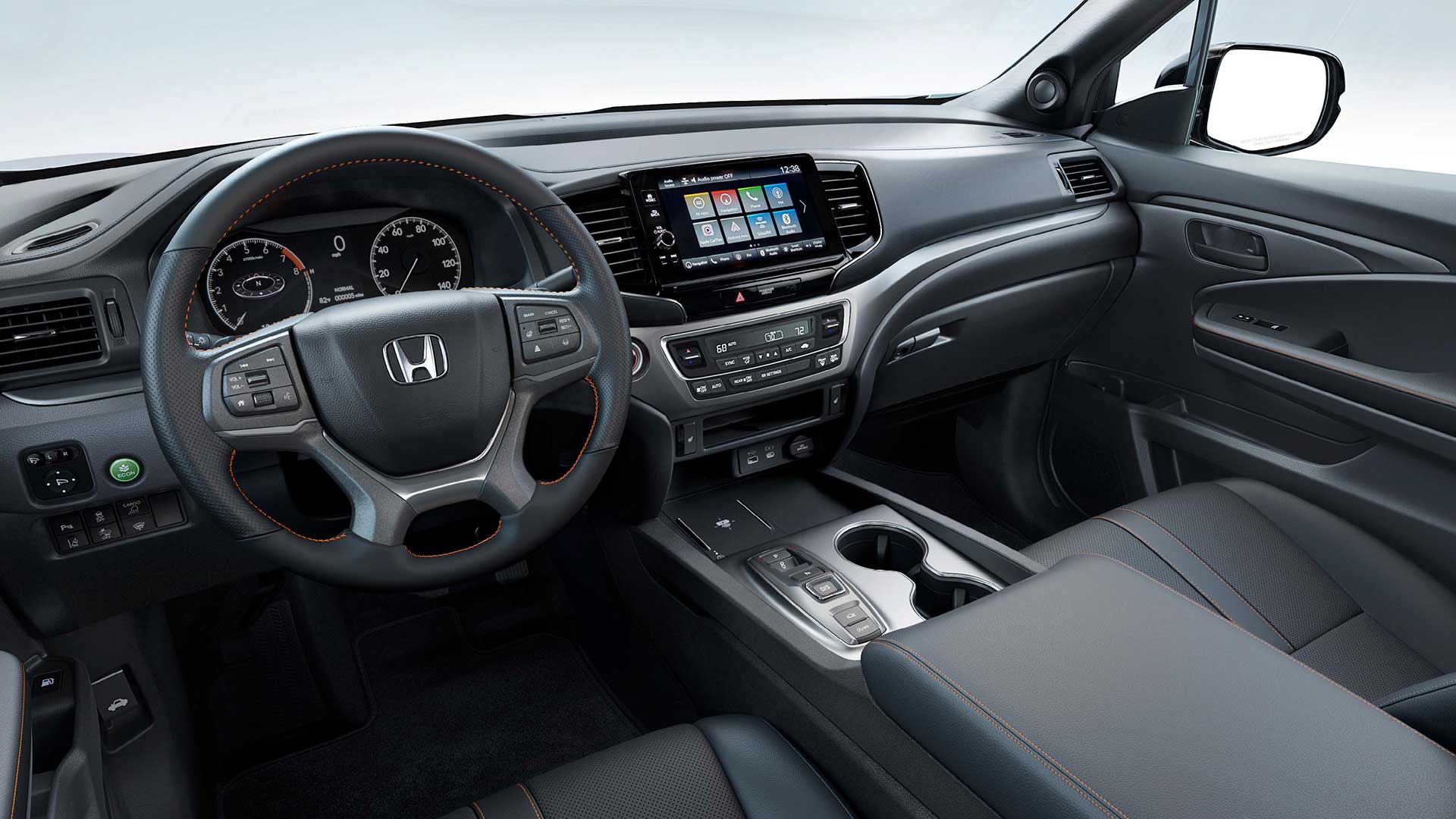
The revised suspension and knobbier tires didn’t really seem to add or detract from handling prowess, as it felt as solid, nimble, and car-like as it always has through our cone course. Perhaps a little less stiff than before, but good feedback, tight steering, and minimal body roll for a pickup, made for a very confidence inspiring experience. In our braking test, we stopped in a respectable average of 123 feet from 60, with only moderate amounts of nosedive and good feel through the pedal.
There is, however, a slight reduction in Government Fuel Economy Ratings with the all-terrain tires; 18-City, 23-Highway, and 20-Combined, our average, right on, at 20.4 mpg of Regular. That’s a slightly below average Energy Impact Score of 14.9 barrels of yearly oil use, with CO2 emissions of 7.4 tons.
TrailSport pricing falls in line just under the Ridgeline’s top Black Edition trim with a starting price of $46,375, about five grand over a base Ridgeline Sport.
So, whether you consider the Honda Ridgeline to be a “real” truck or not, this ruggedly smooth 2024 TrailSport does truck-like things better than ever. And we’re not just talking about the slight upgrade in off-road performance, we’re talking about a flexible bed to help you get chores done, and the ability to tow or haul with comfort and flexibility other trucks can only wish for. It’s why the Ridgeline brings more first-time buyers to Honda than any other vehicle, and why it continues to be a great choice in the growing midsize truck realm.
Specifications
- Engine: 3.5-liter V6
- Transmission: 9-speed automatic
- Horsepower: 280
- Torque: 262 lb-ft
- EPA: 18 City | 23 Highway | 20 Combined
- 0-60 mph: 7.0 seconds
- 1/4 Mile: 15.5 seconds at 90 mph
- 60-0 Braking (avg): 123 feet
- MW Fuel Economy: 20.4 mpg (Regular)
- Max Towing Capacity: 5,000-lbs








